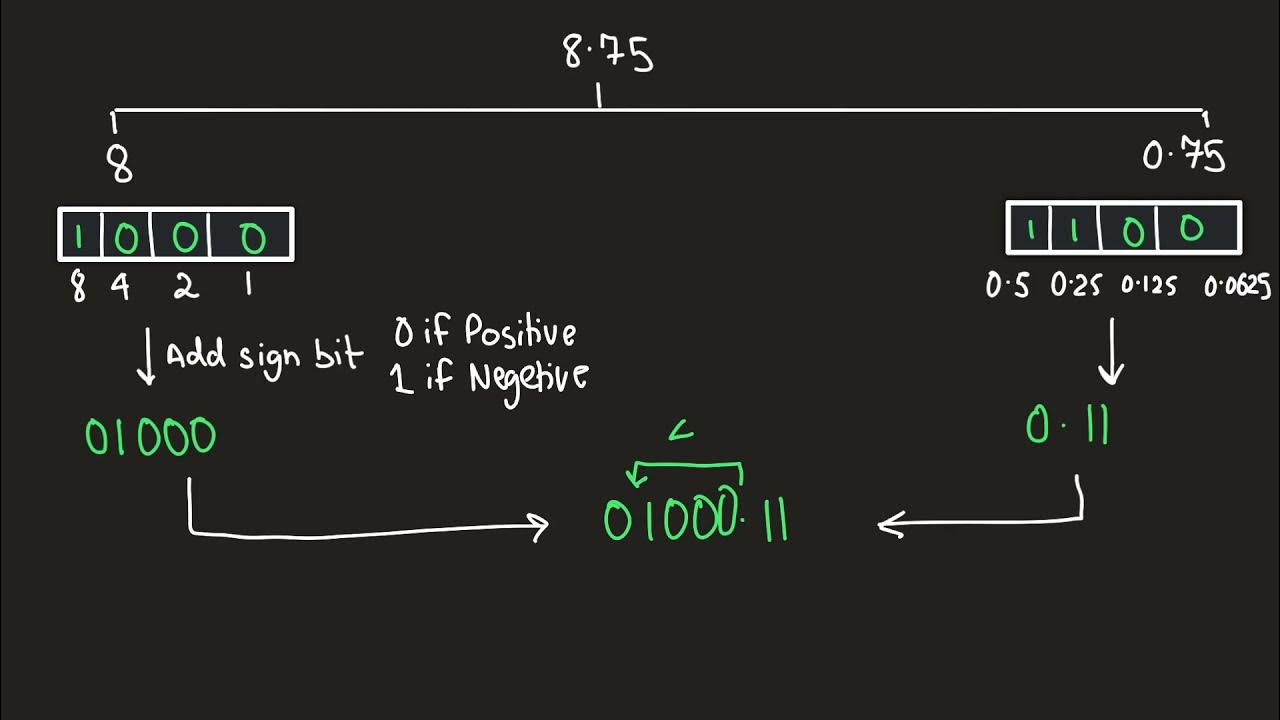80. OCR A Level (H046-H446) SLR13 - 1.4 Floating point binary part 2 - Normalisation
Summary
TLDRThis video, the second in a three-part series, delves into the normalization of floating-point binary numbers. Building on concepts from the previous video, it explains how to convert and represent numbers like 6.5, 2.25, and -2.5 in normalized floating-point format. The video emphasizes the importance of consistent representation for accuracy and demonstrates how to store both positive and negative numbers using two's complement for the exponent. Through practical examples, viewers learn to navigate the complexities of floating-point binary and the significance of normalization in computer representation of real numbers.
Takeaways
- 😀 This video is the second part of a three-part series on floating-point binary.
- 😀 The video focuses on normalization of floating-point binary numbers.
- 😀 Floating-point numbers are represented with a fixed number of bits for the mantissa and exponent.
- 😀 Normalization ensures there is only one consistent way to represent a given floating-point number.
- 😀 Positive normalized numbers start with '01', while negative normalized numbers start with '10'.
- 😀 The script provides examples of converting numbers into base 10 using floating-point representation.
- 😀 An example shows how to represent the base 10 number 6.5 in normalized floating-point binary.
- 😀 The exponent indicates how to move the binary point to normalize the number.
- 😀 The process of converting negative numbers involves flipping bits and adjusting the exponent accordingly.
- 😀 The video concludes with a recap of how to check if the stored numbers are correct through conversion back to base 10.
Q & A
What is the purpose of normalization in floating point binary numbers?
-Normalization ensures a consistent representation of floating point binary numbers, maximizing accuracy and preventing ambiguity in number representation.
How do positive and negative normalized floating point numbers differ in their binary representation?
-Positive normalized numbers start with '01', while negative normalized numbers start with '10' in binary representation.
What is the significance of the exponent in floating point binary representation?
-The exponent indicates how many places to move the binary point in the mantissa to achieve the correct representation of the number in its normalized form.
How do you convert the binary number '0001010' to decimal?
-The binary number '0001010' converts to decimal 1 by applying the binary number line, where each bit represents a power of 2.
What steps are involved in normalizing the number 6.5 into floating point binary?
-To normalize 6.5, first convert it to binary ('110.1'), move the binary point to the normalized position ('0.1101'), determine the exponent (+3), and represent the mantissa and exponent in the appropriate format.
How is a negative number represented in floating point binary?
-To represent a negative number, first write its positive version, then invert the bits after the first '1', and follow the normalization steps with the appropriate starting bits for negatives.
What is two's complement and why is it used in floating point binary representation?
-Two's complement is a method of representing signed integers in binary, allowing for straightforward arithmetic operations and easy conversion between positive and negative numbers.
How can you verify the accuracy of a stored floating point binary number?
-To verify, convert the floating point binary representation back to decimal by applying the exponent to move the binary point and then summing the values represented by the mantissa.
What is the final representation of the decimal number -0.25 in normalized floating point binary?
-The final representation of -0.25 in normalized floating point binary is '101000', which includes the appropriate mantissa and exponent.
What challenges arise from having multiple representations of the same number in floating point format?
-Having multiple representations can lead to inconsistencies and potential errors in calculations if a consistent normalization method is not applied.
Outlines

This section is available to paid users only. Please upgrade to access this part.
Upgrade NowMindmap

This section is available to paid users only. Please upgrade to access this part.
Upgrade NowKeywords

This section is available to paid users only. Please upgrade to access this part.
Upgrade NowHighlights

This section is available to paid users only. Please upgrade to access this part.
Upgrade NowTranscripts

This section is available to paid users only. Please upgrade to access this part.
Upgrade NowBrowse More Related Video

81. OCR A Level (H446) SLR13 - 1.4 Floating point binary part 3 - Recap and further examples

79. OCR A Level (H046-H446) SLR13 - 1.4 Floating point binary part 1 - Overview

AS & A Level Computer Science (9618) - Chapter 16: ADVANCED Data Representation

Data Representation - Mantissa And Exponents Part 3 - (A Level Computer Science Made Easy (A2) )

82. OCR A Level (H446) SLR13 - 1.4 Floating point arithmetic

Representing Numbers and Letters with Binary: Crash Course Computer Science #4
5.0 / 5 (0 votes)